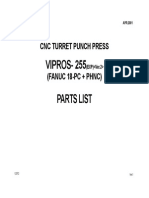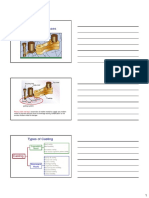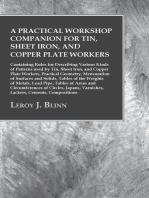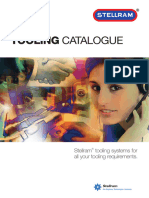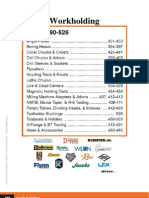Found Ary
Found Ary
Uploaded by
luv_leo007Original Description:
Copyright
Available Formats
Share this document
Did you find this document useful?
Is this content inappropriate?
Report this DocumentCopyright:
Available Formats
Found Ary
Found Ary
Uploaded by
luv_leo007Copyright:
Available Formats
Casting methods
Metal casting process begins by creating a mold, which is the reverse shape of the part we need. The mold is made from a refractory material, for example, sand. The metal is heated in an oven until it melts, and the molten metal is poured into the mould cavity. The liquid takes the shape of cavity, which is the shape of the part. It is cooled until it solidifies. Finally, the solidified metal part is removed from the mould. A large number of metal components in designs we use every day are made by casting. The reasons for this include: (a) Casting can produce very complex geometry parts with internal cavities and hollow sections. (b) It can be used to make small (few hundred grams) to very large size parts (thousands of kilograms) (c) It is economical, with very little wastage: the extra metal in each casting is re-melted and re-used (d) Cast metal is isotropic it has the same physical/mechanical properties along any direction. Common examples: door handles, locks, the outer casing or housing for motors, pumps, etc., wheels of many cars. Casting is also heavily used in the toy industry to make parts, e.g. toy cars, planes, and so on. Table 1 summarizes different types of castings, their advantages, disadvantages and examples.
Sand casting
Sand casting uses natural or synthetic sand (lake sand) which is mostlya refractorymaterial called silica (SiO2). The sand grains must be small enoughso that it can be packed densely;however, the grains must be large enough to allow gasses formed during the metal pouring to escape through the pores. Larger sized molds use green sand (mixture ofsand, clayand some water). Sand can be re-used, and excess metal poured is cut-off and re-used also.
Typical sand molds have the following parts (see Figure 2): The mold is made of two parts, the top half is called the cope, and bottompart is the drag. The liquid flows into the gap between the two parts, called the mold cavity. The geometry of the cavityis created by the use of a wooden shape, called the pattern. The shape of the patterns is (almost) identical to the shape of the part we need to make. A funnel shaped cavity;the top ofthe funnel is the pouringcup; the pipe-shaped neck ofthefunnel is the sprue the liquid metal is poured into the pouring cup, and flows down thesprue.
The runnersare the horizontal hollow channels that connect the bottomof the sprue to the mould cavity. The region where anyrunner joins with the cavityis called the gate. Some extra cavities are made connecting to the top surface of the mold. Excess metal poured into the mould flows into these cavities, called risers. Theyact as reservoirs; as the metal solidifies inside the cavity, it shrinks, and the extra metal fromthe risers flows back down to avoid holes in the cast part. Ventsare narrow holes connecting the cavity to theatmosphere to allow gasses and the air in the cavityto escape. Cores: Manycast parts have interior holes (hollow parts), or other cavities in their shape that are not directlyaccessible from either piece of the mold. Such interior surfacesare generated byinserts called cores. Cores are made by baking sandwith some binder so that theycan retain their shape when handled. The mold is assembled byplacing the coreinto the cavityof the drag, and then placing the cope on top, and locking the mold. After the casting is done, the sand is shaken off, and thecore is pulled awayand usually broken off. Important considerations for casting: (a) How do we make the pattern? Usuallycraftsmen will carvethe part shape byhand and machines to the exact size. (b) Whyis the pattern not exactlyidentical to the part shape? - you only need to make the outer surfaces with the pattern; the inner surfaces are made bythe core - you need to allow for the shrinkage of the casting after the metal solidifies (c) If you intersect the plane formed by the mating surfaces of the drag and cope with the cast part, you will get a cross-section of the part. The outerpart ofthe outline of this cross section is called the parting line. The design of the mold is done byfirst determining the parting line (why?) (d) In order to avoid damaging the surface of the mould when removing the pattern and the wood-pieces for the vents, pouring cup and sprue, risers etc., it is important to incline the vertical surfaces of the part geometry. This (slight) inclination iscalled a taper.Ifyou know that your part will be made bycasting, you should taper the surfaces inthe original part design.
(e) The core is held in position by supporting geometrycalled core prints (see figure below). If the design is such that there is insufficient support to hold the core in position, then metal supportscalled chaplets are used. The chaplets will be embedded inside the final part.
(f) After the casting is obtained, it must be cleaned using air-jet or sand blasting
(g) Finally,the extra metal near the gate, risers and vents must be cut off, and critical surfaces are machined to achieve proper surface finishand tolerance.
Shell-mold casting
Shell-mold casting yields better surface qualityand tolerances. The process is described as follows: - The 2-piece patternis made of metal (e.g. aluminumor steel), it is heated tobetween 175C-370C, and coated with a lubricant, e.g. silicone spray. - Each heated half-pattern is covered with a mixture of sand anda thermoset resin/epoxy binder. The binder glues a layer of sand to the pattern, forming a shell. The process maybe repeated to get a thicker shell. - The assembly is baked to cure it. - The patterns are removed, and the two half-shells joined togetherto formthe mold; metal is poured into the mold. - When the metal solidifies, the shell is broken to get the part.
Expendable-pattern casting (lost foamprocess)
The pattern used in this process is madefrompolystyrene(this is the light, white packaging material which is used to packelectronics inside the boxes). Polystyrene foam is 95%air bubbles, and the material itself evaporates when the liquidmetal is poured on it. The pattern itself is made bymolding the polystyrene beads and pentane are put inside an aluminum mold, and heated; it expands to fill the mold, and takes the shape of the cavity. The pattern is removed, and used for the casting process, as follows: - The pattern is dipped in a slurryof water and clay(or other refractorygrains);it is dried to get a hard shell around the pattern. - The shell-covered pattern is placed in a container with sand for support, andliquid metal is poured from a hole on top. - The foamevaporates as the metal fills the shell; upon cooling and solidification, the partis removed by breaking the shell. The process isuseful since it is verycheap, and yields good surface finish and complex geometry. There are no runners, risers, gating or parting lines thus the design process is simplified. The process isused to manufacture crank-shafts for engines, aluminumengine blocks, manifolds etc.
Investment casting (lost wax process)
This is an old process, and has beenused since ancient times to make jewellery therefore it is of great importance to HK. It is also used to make other small (few grams, though it can be used for parts up to a few kilograms). The steps of this process are shown in the figure 10 below. An advantage of this process is that the wax can carry very fine details so the process not only gives good dimensional tolerances, but also excellent surface finish; in fact, almost any surface texture as well as logos etc. can be reproduced with very high level of detail.
Vacuum casting
This process is also called counter-gravity casting. It is basically the same process as investment casting, except for the step of filling the mold (step (e) above). In this case, the material is sucked upwards into the mould by a vacuum pump. The figure 9 below shows the basic idea notice how the mold appears in an inverted position from the usual casting process, and islowered into the flask with the molten metal. One advantage of vacuum casting is that by releasing the pressure a short time after the mold is filled, we can release the un-solidified metal back into the flask. This allows us to create hollow castings. Since most of the heat is conducted away from the surface between the mold and the metal, therefore the portion of the metal closest to the mold surface always solidifies first; the solid front travels inwards into the cavity. Thus, if the liquid is drained a very short time after the filling, then we get a very thin walled hollow object, etc. (see Figure 10).
Permanent mold casting
Here, the two halves of the mold are made of metal, usually cast iron, steel, or refractoryalloys. The cavity, includingtherunners andgating system are machinedintothemold halves. For hollow parts, either permanent cores (made of metal) or sand-bonded ones maybe used, dependingon whether the core can beextracted from the part without damage after casting. The surface of the mold is coated with clayor other hard refractory material this
improves the life of the mold. Before molding, the surfaceis covered with a sprayof graphite or silica, which acts as a lubricant. This has two purposes it improves the flow of the liquid metal, and it allows the cast partto be withdrawn fromthe mold more easily. The process can beautomated, and therefore yields high throughput rates. Also, it produces very good tolerance and surface finish. It is commonlyused for producing pistons used in car engines,gear blanks, cylinder heads, and other parts made of low melting point metals, e.g. copper,bronze, aluminum, magnesium, etc.
Die casting
Die casting is a verycommonlyused type of permanent mold casting process.It is used forproducing many components of home appliances (e.g rice cookers,stoves, fans, washing and drying machines, fridges), motors, toys and hand-tools since Pearl river delta is a largest manufacturerof such products in the world, this technologyis used bymanyHK-based companies. Surface finish and tolerance of die cast parts is so good that there is almost no postprocessing required. Die casting molds are expensive, and require significant lead time to fabricate; theyarecommonlycalled dies. There are two common types of die casting: hot- and cold-chamberdie casting. Ina hot chamber process(used for Zinc alloys, magnesium) the pressure chamber connectedto the die cavity is filledpermanently in the molten metal. The basic cycle of operation is as follows: (i) die is closed andgooseneck cylinder isfilled with molten metal; (ii) plunger pushes molten metal through gooseneck passage and nozzle and into the die cavity; metal is held under pressure until it solidifies; (iii) die opens and cores, if any, are retracted; casting stays in ejector die; plunger returns, pulling molten metal back through nozzle and gooseneck; (iv) ejector pins push casting out of ejector die. As plunger uncovers inlet hole, molten metal refills gooseneck cylinder. The hot chamber process is used for metals that (a) have low melting points and (b) do not alloy with the die material,steel; common examples are tin, zinc, and lead. Ina cold chamber process, the molten metal is poured into the coldchamber in each cycle. The operating cycle is (i) Die is closedand molten metal is ladled into the cold chamber cylinder; (ii) plunger pushes molten metal into die cavity; the metal is held under high pressure until it solidifies; (iii) die opens and plunger follows to push the solidified slug fromthe cylinder, iftherearecores, they are retracted away;
(iv)ejectorpins push casting off ejector die and plunger returns to original position. This process is
particularly useful for high melting point metals such as Aluminum, and Copper (and its alloys).
Figure 11 (a) Hot chamber die casting (b) Cold chamber die casting
Centrifugal casting
Centrifugal casting uses a permanent mold that is rotated about its axis at a speed between 300 to 3000 rpm as the molten metal is poured. Centrifugal forces cause the metal to bepushed out towards the mold walls, where it solidifies after cooling. Parts cast in this method have a fine grain microstructure, which is resistant to atmospheric corrosion; hence this method has been used to manufacture pipes. Since metal is heavier thanimpurities, most of the impurities and inclusions are closer to the inner diameter and can be machined away. surface finishalong the inner diameter is also much worse than along the outer surface.
Drafts and tapers
It is not good for a casting to have surfaces whose normal is perpendicular to the direction along which the part will be ejected fromthe mold. This can cause the part to stick in the mold and forceful ejection will cause damage to the part (and mold, if the mold is re-usable). Therefore all such surfaces are tilted bya small angle (between 0.5and 2) so as to allow easyejection. Draft angles on the inner surfaces of the part are higher, since the castpart also shrinks a littlebit towards the core during solidification and cooling. An illustration of this principle was shown in Figure 3. .Shrinkage As thecasting cools, the metalshrinks. For commoncast metals,a 1%shrinkage allowance is designed in alllinear dimensions (namely,the design is scaled p byapprox 1%). Since the solidification front, i.e. the surface at the boundary of the solidified and the liquid metals, travels fromthe surface of the mold to the interior regions of thepart, the design must ensure that shrinkage does not cause cavities. Figure 18.Poor and preferred design examples [source: Kalpakjian & Schmid]
.Parting line
The parting line is the boundarywhere the cope, drag and the part meet. If the surface of the cope and drag are planar, then the parting line is the outline of the cross-section ofthe part along that plane. You can easily see the parting line for manycast and molded parts that you commonlyuse. It is conventional that the parting line should be planar, if possible. A verysmall of metal will alwaysleak outside the mold between the cope and the drag in anycasting. This is called the flash.If the flash is along an external surface, it must be machined away bysomefinishing operation. Ifthe parting line is along an edge of the part, it is less visible this is preferred.
Machine Dimensions (Length x Width x Height) 1940 x 2300 x 2600 Total weight (without dielectric) 3460 X, Y, Z axes X, Y, Z axes travels 500 x 350 x 426 U, V axes travels 70 Taper angle/height 30/100 Work area Workpiece dimensions (Length x Width x 1050 x 650 x 420 Height) Max. workpiece weight (with/without bath) 400/800 Volume of dielectric 1000 Wire circuit Available wire diameters (Standard) 0.33 - 0.15 Available wire diameters (Option) 0.10 0.07 Manufacturing quality Best surface finish (Standard) 0.2 Best surface finish (with SF Module) <0.1
mm kg mm mm /mm mm kg l mm mm m m
You might also like
- VIPROS-255 Ver. 2 Parts List PDFDocument468 pagesVIPROS-255 Ver. 2 Parts List PDFjcsantosr100% (1)
- 2162 - Ch3 - Review Questions & Solutions - AY20202021Document20 pages2162 - Ch3 - Review Questions & Solutions - AY20202021lalalalaNo ratings yet
- Sand Castingj ReportDocument24 pagesSand Castingj ReportseifelsaieNo ratings yet
- Introduction 1.. FoundryDocument112 pagesIntroduction 1.. FoundryDhananjay Shimpi100% (1)
- NADCA Tolerances 2009Document44 pagesNADCA Tolerances 2009Tom Hagerty100% (1)
- Winsem2015 16 Cp0409 20 Jan 2016 Rm01 Amt Unit I Question BankDocument5 pagesWinsem2015 16 Cp0409 20 Jan 2016 Rm01 Amt Unit I Question BankAnit JainNo ratings yet
- Metal Casting NotesDocument14 pagesMetal Casting NotesMathew Joel MathewNo ratings yet
- Sand Casting and Other Casting ProcessesDocument74 pagesSand Casting and Other Casting ProcessesRashid Kareem100% (1)
- MT Merged PDFDocument273 pagesMT Merged PDFavcNo ratings yet
- BMP Module IDocument36 pagesBMP Module IBiswajit LME016No ratings yet
- Manufacturing ProcessesDocument134 pagesManufacturing ProcessesB J ISAC ABRAHAM PAULNo ratings yet
- Design of The Casting Process For A Spur Gear/Solid Shaft Using Sand Casting Process ObjectiveDocument17 pagesDesign of The Casting Process For A Spur Gear/Solid Shaft Using Sand Casting Process ObjectiveYonas YG100% (2)
- BME UNIT2 ClasssDocument30 pagesBME UNIT2 ClasssUpendra NeravatiNo ratings yet
- Sand Casting OverviewDocument166 pagesSand Casting Overviewsamurai7_77100% (1)
- Differences Between Metal Forming Process and Casting ProcessDocument21 pagesDifferences Between Metal Forming Process and Casting ProcessFarhana Eyla75% (4)
- Overviews: Estimators Parts Widgets Processes Materials Suppliers NewsDocument113 pagesOverviews: Estimators Parts Widgets Processes Materials Suppliers Newsrupesh89890% (1)
- MOdule II 2 PageDocument2 pagesMOdule II 2 PageVyshakh SunilNo ratings yet
- Casting ProcessDocument40 pagesCasting Processharish3742No ratings yet
- Permanent Mold CastingDocument3 pagesPermanent Mold CastingNirav patelNo ratings yet
- Production TechnologyDocument60 pagesProduction Technology2mohan7100% (2)
- Casting:-: Terms Related To Casting ProcessDocument55 pagesCasting:-: Terms Related To Casting ProcessAjay RohillaNo ratings yet
- Casting & Welding Engineering (IE 203)Document23 pagesCasting & Welding Engineering (IE 203)Ganesh Badgire ReddyNo ratings yet
- 15ae307j - Aees - Unit 3Document41 pages15ae307j - Aees - Unit 3Aahana KhannaNo ratings yet
- Basic Mechanical EngineeringDocument70 pagesBasic Mechanical EngineeringHemachandran100% (6)
- Foundry Processes: "Why Whittle When You Can Cast?"Document21 pagesFoundry Processes: "Why Whittle When You Can Cast?"lucasNo ratings yet
- Casting ProcessesDocument20 pagesCasting ProcessesVv4HNo ratings yet
- Chapter 3 CastingDocument35 pagesChapter 3 CastingShalin SharmaNo ratings yet
- Foundary OverviewDocument8 pagesFoundary OverviewPradeep Pandurang JadhavNo ratings yet
- TRVBJNHDocument54 pagesTRVBJNHathahabimNo ratings yet
- Department of Industrial & Production Engineering BUET, Dhaka-1000Document25 pagesDepartment of Industrial & Production Engineering BUET, Dhaka-1000Anshul ShuklaNo ratings yet
- Steps Involved in Sand Casting Process: BY Aravindkumar BDocument39 pagesSteps Involved in Sand Casting Process: BY Aravindkumar BanilNo ratings yet
- MME 512 Note 1Document36 pagesMME 512 Note 1faithNo ratings yet
- Metal Casting Processes: 3.1 Introduction of Casting ProcessDocument14 pagesMetal Casting Processes: 3.1 Introduction of Casting Processharshita gupta100% (1)
- CastingDocument9 pagesCastingapi-3810665No ratings yet
- Wikipedia - FoundaryDocument7 pagesWikipedia - Foundaryshovit singh100% (1)
- MM Experiment ReportDocument10 pagesMM Experiment ReportAbdullah ArshadNo ratings yet
- Unit 1Document27 pagesUnit 1MECH HODNo ratings yet
- Mft-I Two & 13 Marks QuestionDocument16 pagesMft-I Two & 13 Marks QuestionrahulNo ratings yet
- 3 Units NotesDocument159 pages3 Units NotesRaja RamNo ratings yet
- Casting?: Casting Is A Manufacturing Process by Which A LiquidDocument21 pagesCasting?: Casting Is A Manufacturing Process by Which A LiquidAkashShuklaNo ratings yet
- Ae15301 AMMTDocument98 pagesAe15301 AMMTDurai Raj KumarNo ratings yet
- Lec 1 & 2Document43 pagesLec 1 & 2Omar AssalNo ratings yet
- Modern Casting Production MethodsDocument14 pagesModern Casting Production MethodsrabikmNo ratings yet
- MGF Notes - 1Document79 pagesMGF Notes - 1A ABHISHEK MARSHALLNo ratings yet
- Introduction To Casting Processes: BackgroundDocument5 pagesIntroduction To Casting Processes: BackgroundSubhasis BiswalNo ratings yet
- Sand Casting: Over 70% of All Metal Castings Are Produced Via A Sand Casting ProcessDocument45 pagesSand Casting: Over 70% of All Metal Castings Are Produced Via A Sand Casting ProcessSUNDRAMNAGANo ratings yet
- Sand CastingDocument45 pagesSand CastingjmmshahNo ratings yet
- L00. MNU - Sand CastingDocument32 pagesL00. MNU - Sand Castingowarda293No ratings yet
- MP 1st Module NotesDocument39 pagesMP 1st Module NotesKailas Sree ChandranNo ratings yet
- Types of CastingDocument14 pagesTypes of CastingRamoji Aditya Chary100% (2)
- Unit I KRDocument20 pagesUnit I KRSelvaNo ratings yet
- Victa 2 Engine BlockDocument4 pagesVicta 2 Engine BlockJair Parreira50% (2)
- 1st Class 13.01.2020Document18 pages1st Class 13.01.2020EDISON OCHIENGNo ratings yet
- Casting Its TypesDocument84 pagesCasting Its Typesanmanjunath086No ratings yet
- Foundry Asguest57564 Download: Share Add To Flagembed Views: 5846 Category: EducationDocument9 pagesFoundry Asguest57564 Download: Share Add To Flagembed Views: 5846 Category: EducationGurjinder SinghNo ratings yet
- ME1107 Casting AllDocument129 pagesME1107 Casting AllMahmud HridoyNo ratings yet
- Learn Critical Aspects of Pattern and Mould Making in FoundryFrom EverandLearn Critical Aspects of Pattern and Mould Making in FoundryNo ratings yet
- Sheet Metalwork on the Farm - Containing Information on Materials, Soldering, Tools and Methods of Sheet MetalworkFrom EverandSheet Metalwork on the Farm - Containing Information on Materials, Soldering, Tools and Methods of Sheet MetalworkNo ratings yet
- A Practical Workshop Companion for Tin, Sheet Iron, and Copper Plate Workers: Containing Rules for Describing Various Kinds of Patterns used by Tin, Sheet Iron, and Copper Plate Workers, Practical Geometry, Mensuration of Surfaces and Solids, Tables of the Weights of Metals, Lead Pipe, Tables of Areas and CircumferencesFrom EverandA Practical Workshop Companion for Tin, Sheet Iron, and Copper Plate Workers: Containing Rules for Describing Various Kinds of Patterns used by Tin, Sheet Iron, and Copper Plate Workers, Practical Geometry, Mensuration of Surfaces and Solids, Tables of the Weights of Metals, Lead Pipe, Tables of Areas and CircumferencesNo ratings yet
- Home Instruction for Sheet Metal Workers - Based on a Series of Articles Originally Published in 'Metal Worker, Plumber and Steam Fitter'From EverandHome Instruction for Sheet Metal Workers - Based on a Series of Articles Originally Published in 'Metal Worker, Plumber and Steam Fitter'No ratings yet
- Linotype Manual: Giving Detailed Instructions of the Proper Adjustment and Care of the LinotypeFrom EverandLinotype Manual: Giving Detailed Instructions of the Proper Adjustment and Care of the LinotypeNo ratings yet
- WPS Format For Asme Ix - Wps - Fcaw GmawDocument1 pageWPS Format For Asme Ix - Wps - Fcaw GmawThe Welding Inspections CommunityNo ratings yet
- LR Series: Horizontal Turning & Turnmill CentersDocument8 pagesLR Series: Horizontal Turning & Turnmill CentersarzonspacesNo ratings yet
- Drop ForgingDocument18 pagesDrop ForgingpunkhunkNo ratings yet
- Wood Lathe Alpha Optimo 250 Engli. 10Document3 pagesWood Lathe Alpha Optimo 250 Engli. 10ovidiu1965No ratings yet
- Hydrogen-Oxygen Fuel CellDocument5 pagesHydrogen-Oxygen Fuel CellmannarNo ratings yet
- StockDocument440 pagesStockMangBedjoNo ratings yet
- Static Acceptance Test: Ahmed Ramadan Ahmed Saad Sec: 1 ID: 7Document6 pagesStatic Acceptance Test: Ahmed Ramadan Ahmed Saad Sec: 1 ID: 7Ahmed RamadanNo ratings yet
- Introduction To Tool DesignDocument24 pagesIntroduction To Tool DesignBagus Bramantya bagusbramantya.2019No ratings yet
- Data SheetDocument4 pagesData SheetMo HoNo ratings yet
- ASTM A36 MildLow Carbon SteelDocument3 pagesASTM A36 MildLow Carbon SteelAndrés MaiguaNo ratings yet
- Hardness of Die's Components (PSMC) (Recovered)Document4 pagesHardness of Die's Components (PSMC) (Recovered)Subuk T. RathodNo ratings yet
- Tapflex Flier 083116BDocument2 pagesTapflex Flier 083116BGerardo JM PalaciosNo ratings yet
- Sa 320Document13 pagesSa 320gst ajahNo ratings yet
- Kapselmutter: Ausgabe/Edition 2005-11Document9 pagesKapselmutter: Ausgabe/Edition 2005-11Ravi VermaNo ratings yet
- Welding DefectsDocument22 pagesWelding DefectsAnil KumarNo ratings yet
- ME3301 Press Tool DesignDocument86 pagesME3301 Press Tool DesignViplav Kumar SinghNo ratings yet
- Experiment No. 7: To Perform Drilling Operation On LatheDocument3 pagesExperiment No. 7: To Perform Drilling Operation On LatheHasnain Ashraf100% (2)
- CNC Milling and Horizontal Milling MachineDocument7 pagesCNC Milling and Horizontal Milling MachineAsma PrinceNo ratings yet
- Skd61-Mould Steel Aisi h13Document2 pagesSkd61-Mould Steel Aisi h13Agustine SetiawanNo ratings yet
- General Catalogue Stellram 2002Document644 pagesGeneral Catalogue Stellram 2002Vlad MiticaNo ratings yet
- Manual Thread Cutting - Course - Technique For Manual Working of Materials. Trainees' Handbook of Lessons - 7 PDFDocument7 pagesManual Thread Cutting - Course - Technique For Manual Working of Materials. Trainees' Handbook of Lessons - 7 PDFHenrique MarquesNo ratings yet
- Work HoldingDocument138 pagesWork HoldingHuron Industrial SupplyNo ratings yet
- MID Paper Manufacturing Processes (Fall 2020)Document2 pagesMID Paper Manufacturing Processes (Fall 2020)Muhammad Nouman khanNo ratings yet
- 31 Screw Threads and Gear Manufacturing MethodsDocument17 pages31 Screw Threads and Gear Manufacturing MethodsPRASAD326100% (8)
- Alcoa CamlocDocument81 pagesAlcoa CamlocWK SinnNo ratings yet
- Micro Milling Cutting Forces On Machining Aluminum AlloyDocument22 pagesMicro Milling Cutting Forces On Machining Aluminum AlloyAlexander Alfonso AlvarezNo ratings yet
